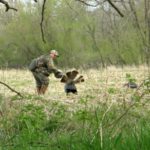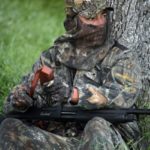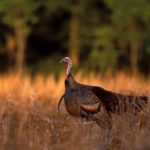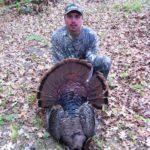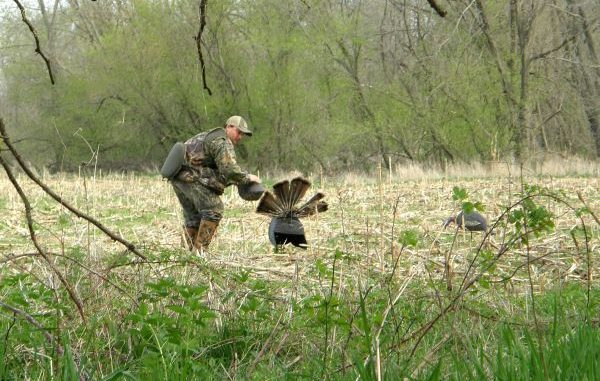
Killing a gobbler as the season is winding down is all about understanding what makes them tick.
Veteran turkey hunter Randy Stafford remembers well one late-season hunt for a very wizened longbeard. “This old gobbler would not roost in the same place two days in a row,” the 65-year-old president of the Louisiana Chapter of the National Wild Turkey Federation said. “On the morning after the first hunt for that bird, we heard him gobbling far away from us.” Stafford and his hunting partner saw the bird in a field with two other gobblers later in the afternoon.
“I remember hearing him at what would be fly-down the next morning at 80 yards away,” Stafford said. “All three birds gobbled at fly-down time. I yelped; he gobbled — and we did this for two hours.
“Finally a hen came up, and all three gobblers finally flew down.”
Unfortunately, Stafford and his buddy had to leave that day without getting a shot at any of the gobblers.
“We came back a week-and-a-half later,” the Franklinton hunter said. “By the time the bird gobbled in the morning, we couldn’t set up. He then roosted again that evening.
“On the next morning, we set up and the bird began gobbling a couple of times. I then just decided to do a fly-down with a wing and gave it a few minutes. We didn’t use any hen calls at all. I also did some scratching in the leaves where we were set-up.”
The hunter said two gobblers flew down some 30 yards away.
“One of those died that morning,” Stafford said. “This goes to show you that when it’s April and late in the season you have to get in there and do something other people are not doing.”
By this time in the season, many Louisiana gobblers have been traumatized by being owled to, crowed to, yelped at and just plain pressured by all the turkey hunters moving in the woods.
So Stafford, former NWTF Louisiana field staff member Chad Bowen of Winnfield and Creston’s Glen Williams — all of whom have plenty of experience with late-season gobblers — agreed to share their secrets to success.
Stay late
“Usually in the late season, the hens will be leaving the gobblers early, as more of them will be apt to go nest as opposed to staying around,” the 43-year-old Bowen said. “Lots of hunters will, unfortunately, give up way too early and therefore miss some later possibilities at killing a good bird.”
He said one of his keys is to hunt later in the day.
“I have killed more birds later in the morning than earlier as the season progresses,” Bowen said.
As for calling tactics, Bowen has a tendency to soften up a bit later in the season.
“I’m somewhat more reserved in my calling then,” he said. “I’ll start off with four to five yelps and try to get a response, although I will call louder sometimes, depending on the bird’s temperament and personality.
“But usually soft calling with basic yelps, purrs and clucks — and then I’ll put my calls down a while.”
If such doesn’t work early, Bowen walks timber roads later in the day in hopes of hearing gobblers or seeing dusting birds.
“Last year, I happened upon a hen in the road and I heard a gobbler sounding off at some distance behind her,” he explained. “I grabbed the fan off my B-Mobile decoy and held it to my face before she stepped out.
“I did some soft calling and she came within 10-yards of me and began feeding. She actually came up so close I could have reached and touched her at one point.”
Later on, the gobbler came in, and Bowen bagged his late-morning longbeard.
And as the days warm up in April, gobblers and hens will usually fly down to the middle of fields, making hunters’ attempts at them rather futile.
“Those field birds have a tendency to pitch out into the center of fields and stay out of gun range,” Bowen said.
He said some hunters have been known to use the B-Mobile strutter decoy successfully to get within range of the gobblers, squating behind either the full decoy or the fan and moving into the field.
Call softly, be patient
Williams has a fondness for hunting the late season on Kisatchie National Forest near Natchitoches.
“It does get tough in the late season — especially on public lands,” he said. “It is very difficult to find a gobbler that has not been called to; they get seriously call-shy.”
The hunter has learned that finding strut zones is important especially if a longbeard cannot be killed at daylight.
“I’ll get set up on a gobbler ahead of him where I know he’ll be going to strut,” Williams explained. “Then all I may do is just sit down and scratch some leaves for a while.
“I’ve taken longbeards that way, because I knew where they were going (to strut), and I have cut them off.”
On other occasions, Williams has been successful at daylight by just sitting down and scratching in the leaves. At fly-down time, he will simulate flapping wings by simply flapping his camo hat.
He hasn’t had much success using decoys on public lands late in the season.
And he said he has to be patient as the season ages.
“You may call, and a gobbler may sound off at first,” Williams said. “If it’s later in the morning, he may move toward you and come in silent and almost run right over you before you shoot him.”
As for calling, Williams advised keeping things quiet.
“Never call loud, but do call softly at first,” he said. “I’ll mostly try soft yelps at first.”
When private-land gobblers hang up, Williams uses a gobble call — something he’d never do on public lands for safety reasons.
As for types of calls, Williams relies on Flextone diaphragms and the Primos Power Crystal glass calls.
But his biggest key is to fight the urge to become frustrated and head home.
“In the late season, you definitely want to stay in the woods,” Williams said. “To be successful, you have to be patient, and you may have to move two to three times and reposition.
“And you can get rewarded if they do get responsive. Sometimes, later in the day they can come in and almost run right over you.”
Take a gobbler’s temperature
Randy Stafford has been turkey hunting in Louisiana since he was a youngster — even when there was a very small population that could be hunted.
So he knows a bit about chasing them, and he admitted the late season is presents the most challenges.
“Later in the season, the birds will certainly gobble less due to hunting pressure,” Stafford said. “Also, on many occasions you’ll find a gobbler that has been pestered by five or six jakes. Therefore, he will just not gobble that much.”
Fear of dominant gobblers also plays into it.
“Subordinate (longbeard) birds will also not gobble a lot because the dominant birds will come up and whip them,” the hunter said.
Stafford has also witnessed gobblers stay on the limb until the hens have made their way to him on the ground to ensure it’s safe to leave the roost.
Stafford finds midday hunting more productive later in the season.
“The hens that are with the gobbler early gradually leave them by midmorning,” Stafford said. “That old bird will be looking for other hens, and they’ll respond better at that time of the day.
“Mid-morning to lunch can be some of the best times to hunt later in the season.”
Stafford said he will “take the temperature” of the bird after making a few initial calling attempts to determine how he should proceed
“He may respond hot or cold, or may move toward you gobbling all the way,” he said. “The type and amount of calling I’ll do is dictated by the response of that particular bird.”
But, like Williams, Stafford said there are some gobblers who won’t make a peep.
“A lot of birds come in silent,” Stafford said. “I think it’s due to the hunting pressure — especially on public lands. The truth is that when they’re silent like that, they slip in and are gone before many hunters know they’ve even been there.
Admittedly, Stafford doesn’t like to hunt silent birds.
“I don’t care if I kill them or not; I don’t enjoy hunting silent gobblers,” he said.
As for specific calls, Stafford said hunters should have an arsenal from which to choose.
“Turkeys react differently to different types of calls,” he said. “Sometimes you can pull out a box or a slate and they respond wildly. At other times, it may be soft calling on a diaphragm.”
Stafford prefers Perfection calls, Pittman calls and Tom Teaser mouth calls.
“I look for calls that are easy for me to use, but I will advise hunters to pick some up and try what works for them,” he said. “Rhythm and cadence is way more important than the sound you’re making.”
But that doesn’t mean birds will respond to any old call.
“You have to know the basics — yelps, purrs, putts and clucks, and you can produce these on a box or slate,” he said. “It’s hard to make a bad call on slate.”
